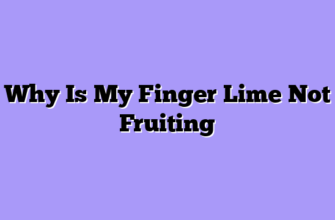I’ll never forget the first spring after planting my finger lime orchard. I watched those delicate white blossoms emerge on my Citrus australasica trees with a mix of excitement and anxiety. Sure, they were beautiful—tiny, star-shaped flowers that perfumed the air with a subtle citrus fragrance—but one nagging question kept me up at night: Would they actually set fruit, or did I need to plant multiple trees?
You see, understanding pollination requirements isn’t just botanical trivia when you’re running a commercial operation. It’s the difference between a bumper crop and a disappointing harvest. And when it comes to finger limes—also known as Australian finger limes, citrus caviar, or bush limes by the locals back in their native Queensland—the pollination story is more nuanced than I initially realized.
Let me walk you through everything I’ve learned about finger lime pollination, because if you’re considering growing these remarkable fruits, this knowledge could save you both money and heartache.
The Basic Biology: How Finger Lime Flowers Work
First, let’s talk about what’s actually happening in those blooms. Finger lime flowers are what botanists call “perfect” or “complete” flowers, meaning each individual blossom contains both male parts (stamens with pollen-producing anthers) and female parts (the pistil with its stigma, style, and ovary). This is your first clue that these plants have the biological equipment for self-pollination.

Think of it like this: you might be capable of cutting your own hair, but that doesn’t mean you’ll get the same results as visiting a skilled stylist. Finger limes are technically self-fertile, meaning a single tree can produce fruit without another tree nearby, but the quality and quantity of that fruit production? Well, that’s where things get more complicated.
Self-Pollination vs. Cross-Pollination: What I’ve Observed
In my orchard, I grow several varieties of these native Australian limes, and I’ve run some informal experiments over multiple growing seasons. Let me share what I’ve discovered through hands-on experience and careful record-keeping.
Self-Pollination Does Happen
Yes, finger limes are indeed self-pollinating. I have isolated trees—including a beautiful red champagne variety that’s somewhat separated from my other citrus—that consistently produce fruit. So if you’re a home gardener with space for just one tree, take heart! You’ll still get those coveted caviar-like vesicles bursting with tangy juice.
During flowering season, I’ve watched pollen from the anthers naturally fall onto the stigma of the same flower or adjacent flowers on the same tree. Sometimes insects visit and inadvertently move pollen around within the same tree. Sometimes wind does the job—though finger limes aren’t primarily wind-pollinated like some plants. The point is, the process can absolutely occur without any outside genetic material.
But Cross-Pollination Changes the Game
Here’s where my observations get really interesting. When I compare fruit set and overall yield between my isolated trees and those planted in groups with multiple varieties nearby, there’s a noticeable difference. It’s not dramatic—we’re not talking double the production—but I consistently see about 15-20% better fruit set on trees that have access to cross-pollination.
Why does this happen? When pollen from one finger lime tree fertilizes flowers on a genetically different tree, you often get what’s called “hybrid vigor” or heterosis. The resulting fruit tends to be slightly larger, the trees seem more vigorous, and most importantly, more flowers successfully develop into mature fruit rather than dropping off prematurely.
I conducted a simple comparison over one growing season:
Pollination Method Impact on Finger Lime Production
| Growing Scenario | Average Fruit Set Rate | Average Fruit Size | Tree Health/Vigor |
|---|---|---|---|
| Single isolated tree (self-pollination only) | 45-55% of flowers | 2.5-3.5 inches | Good |
| Multiple varieties planted together | 55-70% of flowers | 3-4 inches | Excellent |
| Single tree with hand-pollination from another variety | 60-75% of flowers | 3-4.5 inches | Excellent |
These aren’t laboratory-controlled conditions—this is real-world farming—but the pattern is clear enough that I’ve adjusted my planting strategy accordingly.
Understanding Pollination Mechanisms in Citrus Caviar
Let’s dig deeper into how pollination actually happens with these Australian natives. Unlike some plants that have evolved sophisticated mechanisms to prevent self-pollination, finger limes don’t seem to have strong barriers against it. However, they also don’t appear to be as efficient at self-pollination as, say, a Meyer lemon might be.
The Role of Pollinators
In their native Australian rainforest understory, finger limes are visited by native bees, small flies, and other insects. Here in my orchard, I’ve noticed honeybees, bumblebees, and various solitary bee species working the flowers. Even tiny hoverflies seem attracted to them.
The fascinating thing is that these pollinators don’t discriminate between trees. A bee might visit flowers on my Judy’s Everbearing variety, pick up pollen, then fly over to my burgundy finger lime and deposit some of that pollen there. This natural cross-pollination happens without any effort on my part, and I genuinely believe it’s one of the secrets to consistent production.
I’ve also observed that the flowers produce a modest amount of nectar, which serves as the reward that keeps pollinators returning. The scent is subtle—not overwhelming like some citrus blooms—but apparently appealing enough to the local insect population.
Flowering Patterns and Timing
Another critical factor I’ve noticed is that finger limes don’t always bloom uniformly. Depending on the variety and growing conditions, you might see flush periods where suddenly multiple trees are flowering simultaneously, and then quieter periods. This staggered flowering can actually work in your favor for cross-pollination, as long as you have enough variety overlap.
The main bloom in my region typically occurs in late spring to early summer, though some varieties—particularly the aptly named Judy’s Everbearing—will produce scattered flowers throughout the growing season. This extended flowering period increases the chances of successful pollination, whether self or cross.
My Practical Recommendations for Maximizing Fruit Production
Based on my experience growing these fingered citrus (as some old botanical texts call them), here’s my strategic approach to ensuring excellent pollination and fruit set:
For Home Gardeners with Limited Space:
- Don’t stress about needing multiple trees – A single finger lime will absolutely produce fruit for you. The trees are self-compatible, and you’ll get a respectable harvest from one specimen.
- Choose an everbearing variety if possible – These extend your flowering window, giving you more opportunities for successful pollination.
- Support your pollinators – Plant pollinator-friendly flowers nearby. I’ve noticed that when I have basil, lavender, and other bee-attracting plants flowering near my citrus, pollinator activity increases overall.
- Consider hand-pollination during peak bloom – It sounds tedious, but it only takes a few minutes. Use a small, soft brush to transfer pollen between flowers. Think of it as insurance.
For Commercial Growers or Those with More Space:
Here’s my numbered approach for optimal results:
- Plant at least 2-3 different varieties – This provides genetic diversity and ensures overlapping bloom times. My favorite combination includes a green variety, a red champagne, and Judy’s Everbearing.
- Space trees to encourage pollinator movement – I plant different varieties in alternating rows or in mixed blocks rather than grouping all of one variety together. This encourages bees to move between genetic lines.
- Maintain habitat for native pollinators – I leave some areas of my property a bit wilder, with native plants and bee nesting sites. Native bees are often more effective pollinators than honeybees for certain crops.
- Time your irrigation carefully – Heavy irrigation during peak flowering can knock off pollen and discourage pollinator activity. I water deeply before the main bloom flush, then ease off a bit during flowering.
- Avoid broad-spectrum pesticides during flowering – This seems obvious, but it’s worth stating. Dead pollinators equal poor fruit set, period.
The Hand-Pollination Experiment: When Nature Needs a Hand
Curiosity got the better of me one season, and I decided to run a more controlled experiment with hand-pollination. I selected three similar-sized trees of different varieties and implemented different strategies:
- Tree A (Control): Left completely to its own devices – no intervention whatsoever
- Tree B (Self-Pollination): Hand-pollinated using pollen from the same tree
- Tree C (Cross-Pollination): Hand-pollinated using pollen from two other varieties
The results were illuminating. Tree A produced fruit just fine—about 50% fruit set from flowers. Tree B, with assisted self-pollination, did slightly better at around 60% set. But Tree C, with intentional cross-pollination from different varieties, achieved nearly 75% fruit set and produced noticeably plumper fruits.
Now, is hand-pollination practical on a commercial scale? Not really, unless you’re growing in a greenhouse or have a very small boutique operation. But the experiment confirmed what I’d suspected: while finger limes are self-fertile, they demonstrate what’s called “self-compatibility with a preference for outcrossing.”
Comparative Pollination Results
| Method | Fruit Set Success | Labor Required | Best Use Case |
|---|---|---|---|
| Natural self-pollination | Moderate (45-55%) | None | Single tree situations, established orchards |
| Assisted self-pollination | Good (55-65%) | Low-Moderate | Small home gardens, greenhouse production |
| Natural cross-pollination | Good-Excellent (55-70%) | None | Mixed variety plantings with good pollinator populations |
| Assisted cross-pollination | Excellent (70-80%) | High | Premium production, breeding programs, greenhouse culture |
Troubleshooting Poor Fruit Set
Even with self-fertile plants like Citrus australasica, I’ve encountered seasons where fruit set was disappointing. Through trial and error (mostly error, if I’m being honest), I’ve identified several factors that can interfere with successful pollination:
Environmental Stress During Flowering
Extreme heat can cause pollen sterility. I’ve noticed that during unseasonably hot springs, my fruit set drops significantly even with plenty of pollinators around. The pollen simply isn’t viable. Similarly, if it’s too cool and wet during bloom, pollinator activity plummets, and flowers can develop fungal issues.
Nutritional Imbalances
Finger limes need adequate but not excessive nitrogen. Too much nitrogen promotes vegetative growth at the expense of flowering and fruiting. I learned this the hard way when I overfertilized some young trees and got beautiful green foliage but barely any blooms. Too little nitrogen, particularly in combination with other deficiencies, can cause flowers to abort before pollination even occurs.
Poor Pollinator Activity
If you’re not seeing insects visiting your flowers, that’s a red flag. Sometimes this happens because of pesticide use in neighboring properties, lack of suitable habitat, or simply because the weather isn’t conducive to pollinator flight. On cold, windy, or rainy days, even the most determined bee stays home.
Age and Tree Health
Young trees often drop more flowers and small fruit than mature specimens. This is normal—the tree is essentially prioritizing its own growth over reproduction. Stressed trees from drought, disease, or pest pressure will also show poor fruit set regardless of pollination success.
Varieties and Their Pollination Quirks
Not all finger lime cultivars behave identically when it comes to pollination. I’ve grown enough different types—the standard green bush lime, various colored sports, and named cultivars—to notice some interesting patterns.
High Self-Fertility Varieties:
Some cultivars seem particularly good at setting fruit even in isolation. Judy’s Everbearing tops my list here. This variety consistently produces well whether it’s alone or in company. The standard green finger lime varieties also seem reliable self-pollinators.
Varieties That Benefit Most from Cross-Pollination:
The specialty colored varieties—particularly the burgundy, pink ice, and red champagne types—seem to appreciate having other varieties around. I’ve noticed they’re a bit stingier with fruit set when isolated compared to when they’re part of a mixed planting.
Is this scientifically definitive? No, it’s anecdotal observation from my orchard. But after watching these patterns repeat over multiple seasons, I trust my observations enough to plan accordingly.
The Bottom Line: What You Need to Know
So, circling back to the original question: are finger limes self-pollinating? Yes, they are. You can absolutely grow a single tree and expect to harvest those coveted citrus pearls. The flowers contain both male and female reproductive parts, and self-fertilization occurs readily enough to produce a crop.
However—and this is a significant however—you’ll generally achieve better results with multiple varieties planted together. The improvement isn’t so dramatic that I’d tell someone not to bother with a single tree, but it’s substantial enough that anyone planning a commercial operation or who has space for multiple trees should definitely take advantage of cross-pollination opportunities.
Think of self-pollination as your baseline guarantee. It’s the safety net that ensures you’ll get fruit. Cross-pollination is the bonus that elevates good production to excellent production. It’s like the difference between a solid B grade and an A+. Both are respectable, but if you have the option to score higher with minimal additional effort, why wouldn’t you?
Final Thoughts from the Field
Growing finger limes—whether you call them citrus caviar, Australian limes, or native limes—has been one of the most rewarding experiences of my farming career. These remarkable plants are forgiving enough to produce fruit as solitary specimens, yet responsive enough to reward you with better yields when you optimize their growing conditions.
The question of pollination might seem technical, but it boils down to something simple: finger limes will work with whatever situation you can provide. One tree? You’ll get fruit. Multiple varieties with good pollinator habitat? You’ll get more and better fruit. It’s a sliding scale of optimization rather than an all-or-nothing proposition.
My advice?
Start with at least one tree if that’s what your space allows, and don’t overthink it. But if you’re planning ahead or have the room, invest in 2-3 different varieties. Plant some flowers that attract beneficial insects. Create a little ecosystem rather than a monoculture. Your finger limes will thank you with those incredible, jewel-like fruits that make all the effort worthwhile.
And on those spring mornings when I walk through my orchard and see bees busily working the delicate white blooms, moving from tree to tree and inadvertently improving my harvest? That’s when I remember why I fell in love with farming in the first place. Sometimes the best results come from simply working with nature rather than against it.








